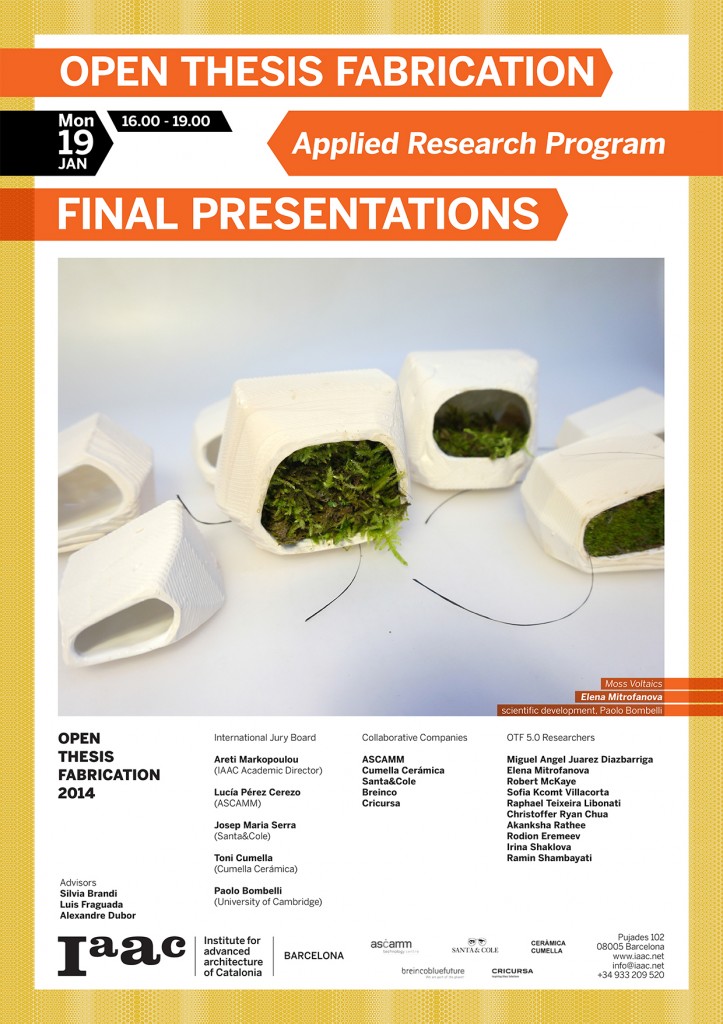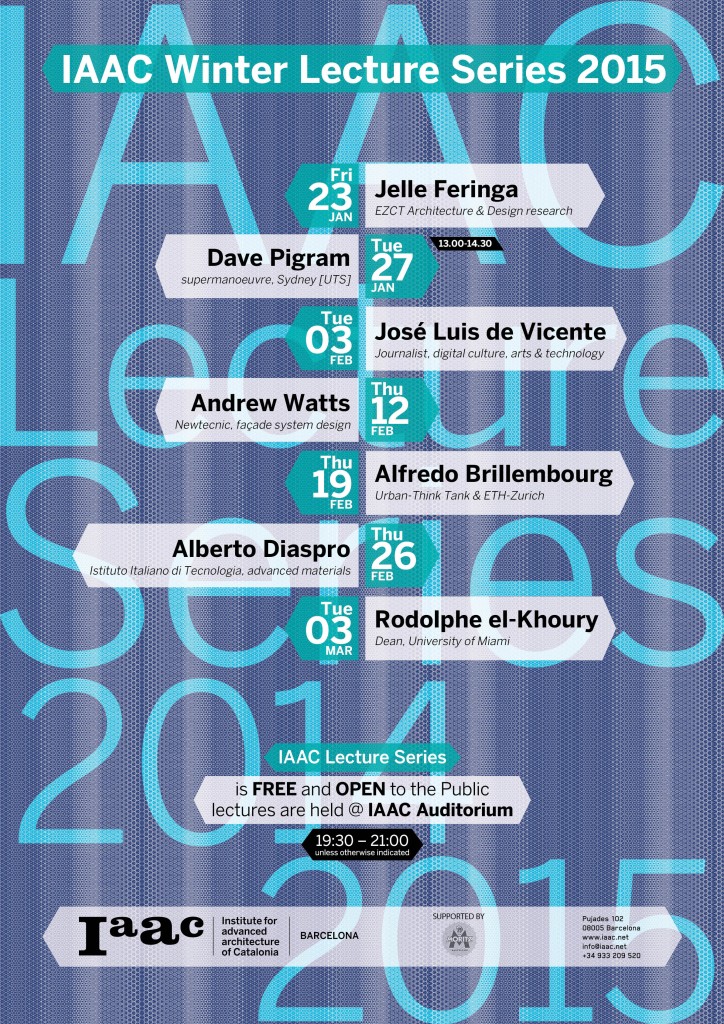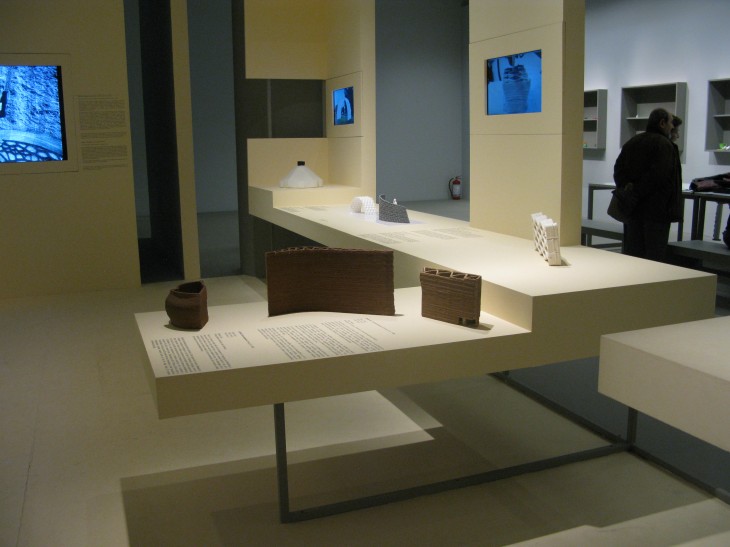IaaC Blog
Inside the Institute
MAA 2014-2015
MAA 02
MAI
Valldaura Labs
Open Thesis Fabrication
Research Trips
Category Archives: Uncategorized
Monday 19th of January // Open Thesis Fabrication // FINAL PRESENTATIONS
Also posted in Final Presentations, IAAC event, Open Thesis fabrication Tagged 2015, academy, applied research, ascamm, breinco, cricursa, cumella ceramica, fabrication, industry, material science, Open Thesis Fabrication, santa&cole, testing Leave a comment
IAAC Research Pylos in 3D Tora Exhibition // Onassis Cultural Centre in Athens
The Pylos Research project, developed by IAAC Fabrication Researcher Sofoklis Giannakopoulos, supervised by Areti Markopoulou, with the Robotic Supervision of Alexandre Dubor, is currently being exhibited in the Onassis Cultural Centre in Athens as part of the 3D Printing Exhibition ”An exhibition from the future… now”.
3-D printing, of everything from houses to hearts and pretty much all you can imagine in-between, is the coming revolution. And not only for industry, but culture and creativity too.
In the first major exhibition in Greece dedicated entirely to this amazing technology, more than 100 pieces by luminaries of Art, Architecture, Fashion, Science, and Product design combine to hint at the transformed commercial, public and private spheres of tomorrow. Read More
IS1 Introductory Studio – Torre Baró Energy District G2 // FINAL PRESENTATIONS
Architecture goes beyond buildings. A building is a concentration of activities in a particular location which should be responsive to concrete cultural, social, economic and technological conditions. In the 21st century, the buildings are more than machines for dwelling in. They should be living organisms, capable of interacting with their environment, following the principles of ecology or biology rather than those of mere construction. In effect, a building should be like a tree, which is able to rooting itself in a particular place, generating its own energy, interacting with the natural networks around it and creating complex ecosystems and landscapes together with other trees.
In this framework the Introductory Studio group 2, led by Edouard Cabay, with Rodrigo Aguirre, presented their projects today to an international jury board composed by: Areti Markopoulou – IAAC Academic Director, Silvia Brandi – IAAC Academic Coordinator, Lluis Víu – Max de Cusa Arquitects, Jordi Pagès – Creative Director & Motion Designer, Jaime Coll – COLL-LECLERC, Pepe Ballesteros – Pasajes Arquitectura, Javier Peña – Xpiral and Marcella del Signore – x-topia.
Also posted in Final Presentations, IAAC event Tagged design, Digital Fabrication, digital tools, Edouard Cabay, energy, form finding, Introductory Studio Leave a comment
DS MAA02 Design Studio – Self-Sufficient Housing Torre Baró // FINAL PRESENTATIONS
Today were the MAA02 Design Studio, directed by Javier Peña, Rodrigo Rubio and Silvia Brandi, Final Presentations. The projects presented were an exercise directed to experimenting with the idea of the self-sufficient habitat. In the occasion of a competition in which IAAC has been invited to participate, along with the other architecture schools of Barcelona, the studio explored the development of a Self Sufficient House. The site is located in Torre baró, in the Collserola hill, between the city of Barcelona and the Collserola Natural Park.
The project proposals were presented to an International Jury board composed by: Areti Markopoulou – IAAC Academic Director, Marjan Colletti – marcosandmarjan design limited, Gonzalo Delacámara – IMDEA and Marcella del Signore – x-topia.
Also posted in Final Presentations Tagged pilot project, prototype, self-sufficient, self-sufficient city, sustainable design Leave a comment
IS1 Introductory Studio – Torre Baró Energy District G1 // FINAL PRESENTATIONS
This year’s group 1 Introductory Studio was developed around a series of questions, posed in reference to the context of Torre Baró: How can we transform a landscape into a productive one? How does water, solar energy, wind or biological processes affect sustainable design cycles for structures and landscape? Which strategies and which technologies are appropriate for such social and environmental context? The Introductory studio will focus on the topics of designing and implementing a self sufficient green house and a productive land, where “production” is understood as the production of food, energy, materials, and knowledge.
The Introductory Studio led by Claudia Pasquero and Carmelo Zappulla focused on the topics of energy, natural process, bio materials and environmental resources. The projects received feedback from an international juryvoard composed by Areti Markopoulou – IAAC Academic Director, Silvia Brandi – IAAC Academic Coordinator, Jonathan Minchin – Green Fab Lab Coordinator, Marjan Colletti – marcosandmarjan design limited, Sandra Manso – UPC and Lluis Víu – Max de Cusa Arquitects.
Also posted in Final Presentations, IAAC event Tagged algae, biology, Carmelo Zappulla, Claudia Pasquero, energy, final presentations, Introductory Studio, solar_energy, wind energy Leave a comment



